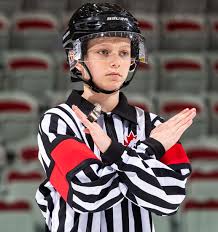A sport of passion and intensity is hockey. To ensure fair play and safety on the ice it is regulated by a set of rules drawn. The most important rule that players and fans should understand is the interference penalty. In this article, we dive into the depths of what an interference penalty requires, its effect on the game, and the nuances that make it both controversial and essential in modern hockey.
More About to Interference Penalty in Hockey
When a player blocks or hinders a competitor who does not have the puck interference in hockey occurs. This can vary from physical interference, such as body checking or holding, to strategic interference, like blocking an opponent’s path without making a play for the puck. It requires a keen observation by officials to impose the rule effectively while few forms of interference are transparent, others are ultra-fine.
Understanding the Rulebook: What Constitutes Interference?
In the case of the NHL or other leagues, the official rulebook of hockey provides clear guidelines on which actions interference accounts for. To promote fair competition and stop teams from obtaining an unfair advantage by illegally these rules are designed.
Hindering their competitors’ movement. Interference of examples include:
- Without attempting to play blocking a competitor from reaching the puck.
- To hinder a competitor’s progress by using physical contact.
- Intentionally getting in the way of a competitor to disturb their play.
Impact on Gameplay and Strategies
Notable impact on gameplay and plan by interference penalties. To avoid costly penalties team must balance aggressive play with conformance to the rule. To minimize interference violations while maintaining a competitive edge on the ice coaches frequently emphasize discipline and smart positioning.
Evolution of Interference Penalties
The idea of interference has developed, reflecting changes in the game’s mechanics and player safety concerns. Early hockey allowed for more physicality, but as the sport progressed, to protect players and promote skillful play stricter rules were executed.
Notable Cases and Controversies
In every part of history, interference penalties have been the subject of many controversies and debates. From vital moments in championship games to star players facing inspection for their playing style, interference calls can oscillate the momentum of a match and catch passionate discussions among fans and analysts.
Player Safety and Fair Play Considerations
Interference penalties are not just about imposing rules; in ensuring player safety they also play an important role. By penalizing actions that could lead to injuries or unfair advantages, hockey leagues organize the well-being of their sportsman and endorse the principles of fair play.
How Officials Enforce Interference Penalties
Due to the game’s speed and complexity, officiating interference can be challenging. To make split-second decisions referees and linesmen go through extensive training, depending on their judgment and the cooperation of video review when necessary to sustain the integrity of the game.
Common Misconceptions Debunked
Surrounding interference penalties many things could be improved, such as confusion between legal body positioning and illegal obstruction. Making clear these misconceptions helps players and fans better understand the nuances of the rule and appreciate its role in acknowledging a level playing field.
Interference Penalty in Different Hockey Leagues
While the basic concept of interference remains compatible across hockey leagues, there may be dissimilarities in how penalties are called and interpreted. Understanding these dissimilarities is important for players competing at different levels and fans following different leagues.
5 minute major penalty regulations in the NBA
Let’s explore the emotional impact and complexities of this resulting penalty.
- The Five Minutes Weight: A 5-minute major penalty is a setback more than just a penalty to a player when he is penalized. it’s an outstanding chunk of game time spent with a drawback. The emotional weight of knowing your team will in deficient for such an important period can be demoralizing.
- Intensity and Tension: When the penalty clock ticks down, the intensity and tension on the ice and in the stands go up. Every goal scored or prevented carries vast emotional weight, every second becomes evaluative, and every play is magnified.
- Team Unity and Resilience: The team is required to unite with flexibility when they face a 5-minute major penalty when players rally to defend their net, their emotions run high, and throughout the challenging moments, support each other, and kill off the penalty.
- Opportunity or Adversity: It depends on which side of the penalty your team is on, from home to frustration emotions can swing. The team that is penalized is a test of flexibility and penalty-killing expertise. It’s an opportunity to capitalize and swing the game in their favor for an opponent team.
- Emotional Rollercoaster: During a 5-minute major penalty rollercoaster of emotions for fans who are watching. Combined signs of relief or disappointment create a dynamic emotional landscape, hopeful expectation, nervous tension, and explosion of excitement.
- Impact on Momentum: The psychological effect of a 5-minute major penalty expands over the penalty itself. The psychological resilience to weather such shifts is a witness to a team’s character.
- Turning Point or Setback: It depends on how the team responds to a 5-minute penalty, it may be a turning point that tosses them to a victory or a setback that requires regrouping and refocusing. Emotions play an important role in how players and teams navigate these critical moments.
- Sportsmanship and Discipline: A 5-minute major penalty is a display of sportsmanship and emotional control to maintain self-control and discipline. Discipline plays a key role, emotions can run high to vanquish the challenges.
- Lessons Learned: A 5-minute major penalty provides valuable lessons in resilience, teamwork, and emotional management win or lose. It is not just about the result of the game but also the growth of players and teams from the experience.
- Celebration or Heartbreak: Emotions blow up in celebrations and heartbreaks when the penalty clock expires. It’s a moment of raw emotion as teams reflect on their efforts, the highs and lows of the game, and the journey they’ve shared.
Coaching Perspectives and Training Tips
To educate the players about the interference rules regulations and techniques to avoid penalties coaches play an important role. Focus attention on disciplined play, strategic positioning, and effective communication on the ice can help teams minimize interference violations and maximize their cut-throat performance.
Let’s dive into some training tips that will not only increase your skills but also burn your love for the game.
- Set Goals with Heart: By setting meaningful goals that resonate with your heart start your training journey. Even if it is a technique, improving your tolerance, or becoming a leader on the ice, let your passion drive your expectations.
- Embrace the Grind: Training is not always exotic. Embrace the grind, the sweat, and the challenges. The moments of struggle that you discover it is in your true strength and determination.
- Fuel Your Passion: Like your body needs fuel similarly your passion for nurturing. With positive influences surround yourself, watch inspirational hockey moments, and stay connected with allies who share your love for the game.
- Practice Mindfully: Quantity is the key to quality, with each repetition focus on improving yourself. Imagine success, trust in your abilities, and stay present in the moment.
- Learn from Setbacks: Setbacks are inescapable in hockey and life. Use setbacks as stepping stones for growth, instead of letting them demoralize you. Scrutinize what went wrong, learn lessons from it, and come back stronger.
- Find Your Rhythm: On the ice, every player has a unique tempo. Even if it is your skating stride, puck-handling style, or defensive tactics, grap what makes you stand out and process it with passion.
- Seek Mentorship: To seek guidance from experienced players, coaches, or mentors don’t ever be afraid or hesitate. In your hockey journey their insights, wisdom, and encouragement can drive you forward.
- Celebrate Progress: No matter how small celebrate every achievement. Let it fuel your motivation, even if it is a new move or improving your speed, acknowledge your progress.
- Rest and Recover: Rest and recovery are important just like training. Listen to your body, prioritize sleep, and give yourself time to recharge. A well-rested player is a determined player.
- Play with Heart: When you step onto the ice, play with your heart. Through your actions, teamwork, and sportsmanship let your love for the game shine. Remember, hockey is not just a sport; it’s a passion that unites us all.
The Future of Interference Penalties in Hockey
Too many rules govern interference, as hockey continues to evolve. Advances in technology, such as enhanced video review capabilities, could lead to more accurate officiating and a deeper understanding of interference’s impact on the game. Balancing tradition with innovation will be key in shaping the future of interference penalties in hockey.
Conclusion
Interference penalties are not just a technicality in hockey; they are a fundamental aspect of fair competition, player safety, and the integrity of the game. Understanding the intricacies of interference and its enforcement enriches the hockey experience for players, coaches, officials, and fans alike.
Read More: What is Spearing in Ice Hockey? | What Is PIM in Hockey?
FAQS
What is a roughing penalty in hockey?
When a player uses unnecessary physical force against a competitor, like pushing or punching, resulting in a period in the penalty box is called a roughing penalty.
Is snowing a goalie a penalty?
Yes, snowing a goalie is a penalty, intentionally snowing into an opponent’s face, is unsportsmanlike conduct and it can lead to a penalty.
What is slashing in hockey?
When a player swings their stick at an opponent is called slashing in hockey, and if it seems excessive or dangerous it can result in a penalty.
What is field hockey interference?
Without making a play for the ball, when a player hinders an opponent’s movement is called field hockey interference, which results in penalties like free hits.


